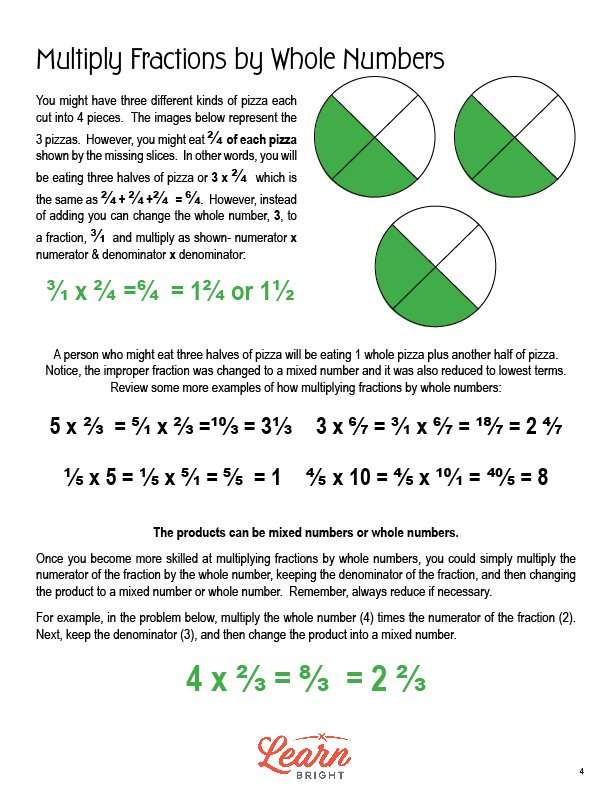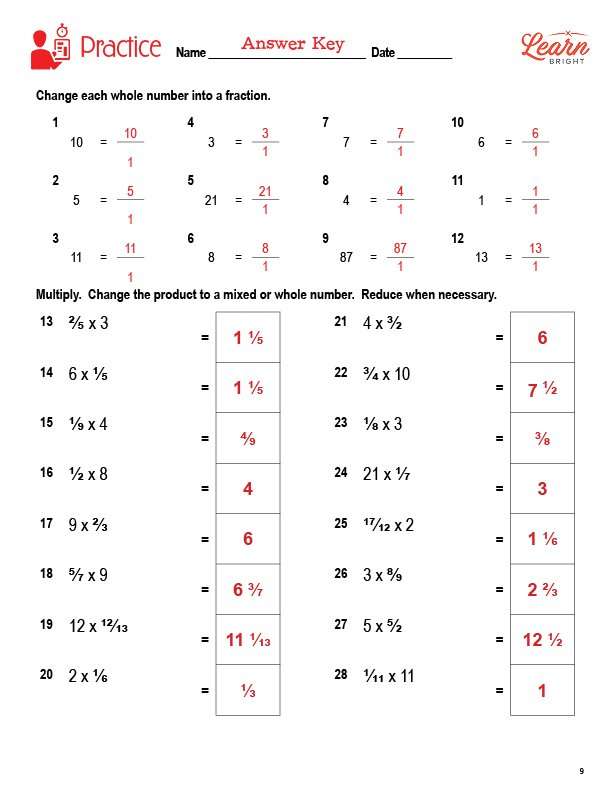Description
What our Multiply Fractions by Whole Numbers lesson plan includes
Lesson Objectives and Overview: Multiply Fractions by Whole Numbers teaches students how to solve multiplication problems where one of the numbers is a fraction. At the end of the lesson, students will be able to change whole numbers to fractions and multiply a fraction by a whole number. This lesson is for students in 4th grade.
Classroom Procedure
Every lesson plan provides you with a classroom procedure page that outlines a step-by-step guide to follow. You do not have to follow the guide exactly. The guide helps you organize the lesson and details when to hand out worksheets. It also lists information in the blue box that you might find useful. You will find the lesson objectives, state standards, and number of class sessions the lesson should take to complete in this area. In addition, it describes the supplies you will need as well as what and how you need to prepare beforehand. The supplies you will need for this lesson include colored pencils or markers, poster paper, and the handouts.
Options for Lesson
Included with this lesson is an “Options for Lesson” section that lists a number of suggestions for activities to add to the lesson or substitutions for the ones already in the lesson. One optional addition to the lesson activity is to have your students vote for the best, most creative, and other categories for the posters. If you want to demonstrate multiplication of whole numbers and fractions using models, you could distribute small candy bars to students or other snacks to use as models. For an additional activity, you could have your students create a quiz to be completed by another student or class. Finally, you could have your students write a paragraph explaining how to multiply a fraction and whole number without using pictures.
Teacher Notes
The teacher notes page includes a paragraph with additional guidelines and things to think about as you begin to plan your lesson. This page also includes lines that you can use to add your own notes as you’re preparing for this lesson.
MULTIPLY FRACTIONS BY WHOLE NUMBERS LESSON PLAN CONTENT PAGES
Multiplication and Whole Numbers
The Multiply Fractions by Whole Numbers lesson plan includes three content pages. You already know how to multiply numbers and know your multiplication facts. Multiplication is simply adding the same number over and over again. For example, 5 x 2 is the same as 2 + 2 + 2 + 2 + 2. When multiplying, you don’t change the problem into an addition problem. You just multiply!
It’s not difficult to multiply whole numbers, especially if you’ve memorized your multiplication facts. It’s also easy to multiply fractions by whole numbers, you just need to turn the whole number into a fraction first. All fractions have a numerator (the top number) and a denominator (the bottom number).
To change whole numbers into fractions, you make the whole number the numerator and the 1 the denominator. For example, 5 becomes 5/1. The fraction 5/1 is the same as 5 ÷ 1 = 5. Remember that the fraction bar or fraction line is sometimes also called the division line.
Once you know how to change whole numbers into fractions, it’s easy to multiply fractions by whole numbers.
Multiply Fractions by Whole Numbers
Say you have three pizzas, each of which is cut into four pieces, and you eat two pieces from each. The lesson shows diagrams of the three pizzas, with 2/4 of each pizza colored in to represent the eaten pieces. If you wanted to figure out how much pizza you ate, you would use the problem 3 x 2/4. This is the same as 2/4 + 2/4 +2/4 = 6/4. However, instead of adding, you change the whole number into a fraction and then multiply: 3/1 x 2/4 = 6/4. You can then change the product into a mixed number: 1 2/4 or 1 1/2. This answer tells you that, if you ate 2/4 of three pizzas, you’re eating 1 1/2 whole pizzas.
To solve these problems, you could also use a shortcut. To do this, you multiply the whole number by the fraction’s numerator and keep the same denominator. You can then change it into a mixed or whole number, reducing if necessary.
For example, let’s look at the problem 4 x 2/3. For this problem, you multiply the whole number (4) by the numerator of the fraction (2): 4 x 2 = 8. Next, keep the denominator as-is and change the product into a mixed number: 8/3 = 2 2/3.
Multiplying fractions by whole numbers is easy! Remember to first change the whole number into a fraction by putting the whole number as the numerator and 1 as the denominator. Once you learn how to solve these problems this way, you can use the shortcut.
MULTIPLY FRACTIONS BY WHOLE NUMBERS LESSON PLAN WORKSHEETS
The Multiply Fractions by Whole Numbers lesson plan includes three worksheets: an activity worksheet, a practice worksheet, and a homework assignment. You can refer to the guide on the classroom procedure page to determine when to hand out each worksheet.
POSTER ACTIVITY WORKSHEET
Students will work with a partner to complete the activity worksheet. Each pair will create a poster showing how to multiply a fraction and whole number. They will use pictures and written instructions to show how to multiply a fraction and whole number, including the steps involved and several examples. Each pair will include a creative title for their poster and will make sure to use proper spelling, grammar, and punctuation. Once completed, they will share the poster with another pair of students. The worksheet includes a rubric that shows how their posters will be graded.
MULTIPLY FRACTIONS BY WHOLE NUMBERS PRACTICE WORKSHEET
For the practice worksheet, students will change 12 whole numbers into fractions. They will also solve 16 multiplication problems, changing the product into a mixed or whole number, reducing when necessary.
WORD PROBLEMS HOMEWORK ASSIGNMENT
The homework assignment asks students to read and solve five word problems. They will also draw a picture showing the problem 5 x 3/4 and solve.
Worksheet Answer Keys
This lesson plan includes answer keys for the practice worksheet and the homework assignment. If you choose to administer the lesson pages to your students via PDF, you will need to save a new file that omits these pages. Otherwise, you can simply print out the applicable pages and keep these as reference for yourself when grading assignments.









